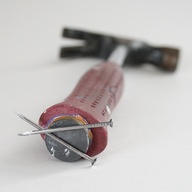In mid-August we had new windows installed in our living room. I decided that I wanted to just have a simple valance at the top of the windows instead of the heavy drapes I had previously used. The windows were just too pretty to cover up. So, I picked out some fabric and set to work sewing valances.
One of the first things I sewed as a newly married woman were valances, and I think they are one of the easiest projects you can sew that can make a big change to any room.
Today I am going to show you how I make valances so that, even if you have limited sewing skills, you can make some, too.
Supplies
- Fabric
- Scissors and/or Rotary Cutter
- Ruler
- Thread
- Iron
- Sewing Machine
To determine the amount of fabric you need you will need to measure the width of your windows and then determine how full you want your your gathers to be. The more fabric you use in the width of your valance the more gathers you will have.
My rule of thumb is to take the width of my window and then cut my fabric to a width that is 1 1/2 times that measurement. Howecer, sometimes I have used a heavy upholstery fabric and made my valances with no gathers by adding only enough width to the fabric to accommodate turning the edges under.
For my living room windows, I made 4 panels because my windows are very wide. I decided that I didn’t want to make one long curtain because the middle needed to be open to accommodate the hook in the middle of the curtain rod that keeps it from bowing.
Since the fabric was striped I cut each panel the width of the fabric (45 inches) by 18 inches. Cutting the valances to a height of 18 inches allowed me to make the curtain rod pocket and hem the fabric without having super short valances.
If this isn’t clear enough please let me know if you need help figuring up how much fabric you need.
Instructions
1. Cut your fabric. As I mentioned above, 18 inches is a good height, and 1 1/2 times the width of your window is a good width for making valances.
2. Overcast (zig-zag stitch) or serge all 4 edges of the fabric. If you use a serger try not to cut much off while you are edging the fabric.
3. Press 1/2 inch of the fabric on both short sides towards the wrong side.
4. Sew the sides in place using a 1/4 or even a 3/8 inch seam allowance.
5. Press the top 3 inches of the fabric towards the wrong side.
(No picture for the next 2 steps.)
6. Sew right along the edge you overcast in Step 2.
7. Sew another seam parallel the the seam you sewed in Step 6. Make the seam 1 1/2 inches (Towards the folded edge.) from the line of stitching you just made in Step 6.
You have just made the pocket that the curtain rod will go through.
8. Press 1 inch of fabric at the bottom towards the wrong side.
9. Sew the hem in place using a 5/8 seam allowance.
This is what your valance should look like from the back side if you have followed all of the steps. I recommend pressing the valance before hanging it up with a curtain rod.
This is the front view when all of the seams have been sewn in place. You will insert the curtain rod between the two lines of stitching which will give you some fabric above the curtain rod.
Here’s a picture of my window with my new valances. My husband said that the stripes make him think of a barber shop, in a good way. I guess that means he likes them.? ![]()
Have you ever made valances? Did you use a similar method? Please let me know if you have any questions.






























